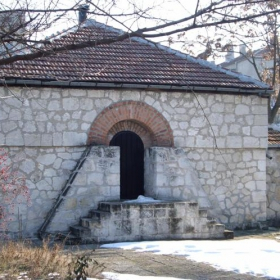
-
 History of Religions
History of the 3 Monotheistic religions (Judaism, Christianity and Islam) and of the main different Christianity confessions (Roman Catholicism, Eastern Catholicism and Eastern Orthodoxy, Anglicanism and Protestantism)
History of Religions
History of the 3 Monotheistic religions (Judaism, Christianity and Islam) and of the main different Christianity confessions (Roman Catholicism, Eastern Catholicism and Eastern Orthodoxy, Anglicanism and Protestantism)
-
 Pedagogical Approaches
New pedagogical approaches to teach history of religion
Pedagogical Approaches
New pedagogical approaches to teach history of religion
-
 Role of Religions in Civilization
How to didactically promote among students of different confessions, the capacity of a critical analysis and understanding of the role played by religions in the history of mankind
Role of Religions in Civilization
How to didactically promote among students of different confessions, the capacity of a critical analysis and understanding of the role played by religions in the history of mankind
-
 Interreligious Students’ Competences
Set of teaching contents, to be used by teachers to highlight and valorize the universal values of tolerance and universalisms that all Monotheistic religions and religious texts contain to promote and sustain mutual understanding among students
Interreligious Students’ Competences
Set of teaching contents, to be used by teachers to highlight and valorize the universal values of tolerance and universalisms that all Monotheistic religions and religious texts contain to promote and sustain mutual understanding among students
-
 Managing Multi-Religious Classes
Teaching Sources to help teachers dealing with multicultural and multi-religious classes
Managing Multi-Religious Classes
Teaching Sources to help teachers dealing with multicultural and multi-religious classes
-
 Introduction
A comparative review of the liturgical celebrations, ceremonies and dietary rules existing in the different religions.
Introduction
A comparative review of the liturgical celebrations, ceremonies and dietary rules existing in the different religions.
-
 Celebrations
Description and comparative analysis of the celebrations of different religions and confessions
Celebrations
Description and comparative analysis of the celebrations of different religions and confessions
-
 Ceremonies
Description and comparative analysis of the ceremonies of different religions and confessions
Ceremonies
Description and comparative analysis of the ceremonies of different religions and confessions
-
 Dietary Rules
Description and comparative analysis of the dietary rules of different religions and confessions
Dietary Rules
Description and comparative analysis of the dietary rules of different religions and confessions
Events
The Pathway through Religions project has been promoted trough conferences and articles.
Partnership
-
 Contractual Partners
From this section it is possible to access to a description of each contractual partner of the Pathway through Religions project.
Contractual Partners
From this section it is possible to access to a description of each contractual partner of the Pathway through Religions project.
-
 Schools
From this section it is possible to access to the information about the schools involved in the Pathway through Religions Project in the European countries involved.
Schools
From this section it is possible to access to the information about the schools involved in the Pathway through Religions Project in the European countries involved.
-
 Associated Partners
As a result of the exploitation activity a number of associated partners officially joined the project in order to contribute to the improvement of the project impact on their target groups and to ensure the project sustainability by continuing using the project deliverables in the next years.
Associated Partners
As a result of the exploitation activity a number of associated partners officially joined the project in order to contribute to the improvement of the project impact on their target groups and to ensure the project sustainability by continuing using the project deliverables in the next years.
This section of the Pathway through Religions portal provides administrative information for the project contractual partners and for the European Commission and it is password protected.
Map
Homepage > ReligiousSite Map > Map

An interactive didactical map interactive didactical map giving access to sites with a religious relevance.
Back to the Religious Sites List

The Roman tomb in Silistra
the town of Silistra, northeastern Bulgaria.
DESCRIPTION OF THE RELIGIOUS SITE
- History and Philosophy of Religions - Religion and the Concept of God
- History and Philosophy of Religions - Christianity
MEDIA RESOURCES
-
JPG
THE ROMAN TOMB IN SILISTRADurostorum, 4thc AD painted tomb in Silistra, Bulgaria, formerly the Roman settlement of Durostorum The tomb is located in the town of Silistra, in the region of the ancient necropolis. It has one chamber, built rectangularly, a semi-cylindrical vault and its entrance is from the East. The walls are made of stone and the vault - of bricks. Its measurements are: 3.30/2.60m/2.30 m. The walls on the inside are entirely covered with murals in the al fresco technique with details in impera al seco. Over a low plinth there runs the basic frieze of 11 panels with human figures on them, whereas over them there are painted trimmer joists at the base of the vault, and compositions are painted in the lunettes and on the vault. The husband and wife buried here are painted on the central panel. A procession of servants with garments and gifts in their hands is depicted on both sides of the couple. In addition, the decoration features peacocks, candle-sticks and birds Hunting scenes, birds, animals and vegetal motifs are painted on the vault. The style shows ancient elements, but it also reflects traits of art in the 4th century to which the tomb is dated. The Silistra Tomb is a rare, wholly preserved monument of late ancient painting. It shows the characteristics of the provincial style It is a unique example of art and life of that particular period in the Thracian lands.
VIDEOS
-
THE ROMAN TOMB IN SILISTRA
The video presents a lot of information about the ancient tomb.
LINKS
-
THE ROMAN TOMB IN SILISTRA
Information about the tomb.
